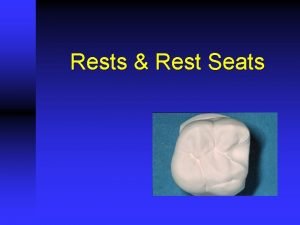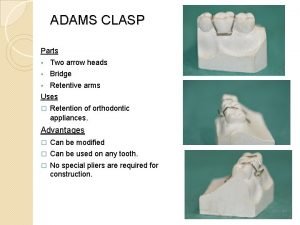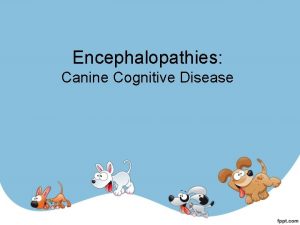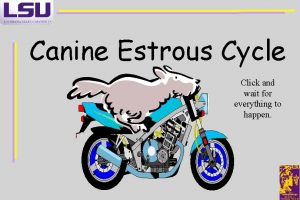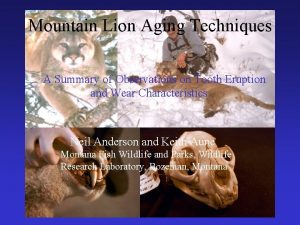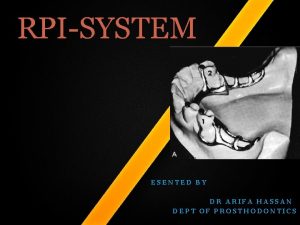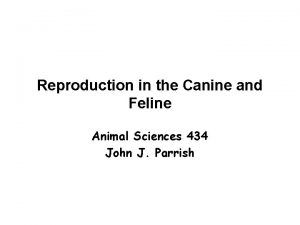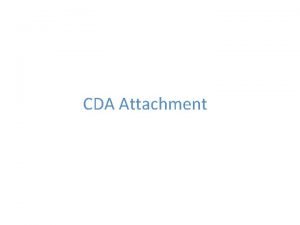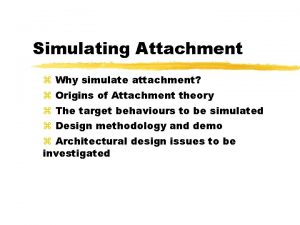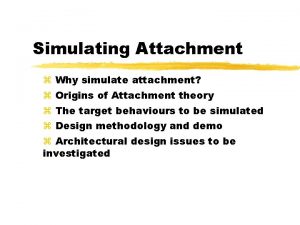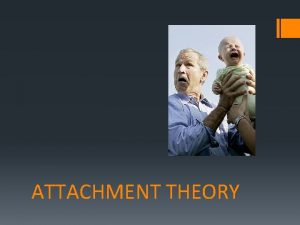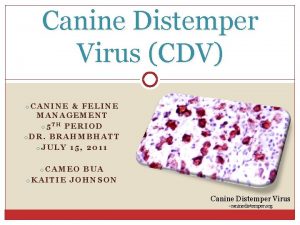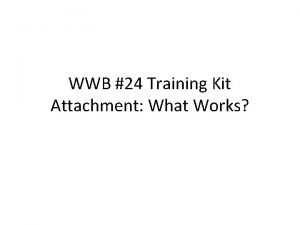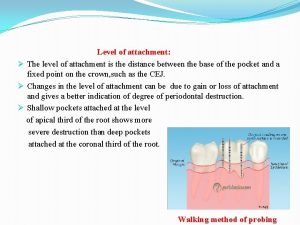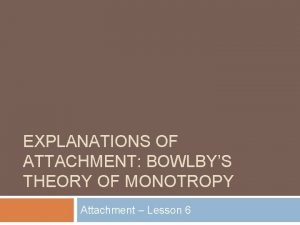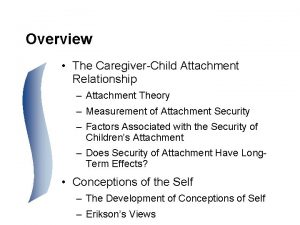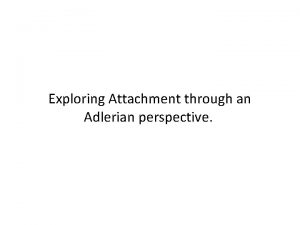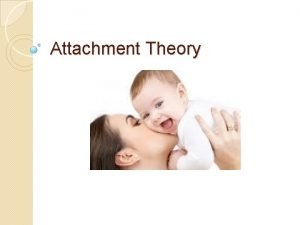Canine Attachment They like us they really like





























- Slides: 29

Canine Attachment They like us, they really like us!

Dogs show strong attachment to people • Strong and large body of evidence that shows dogs show social attachment to people • What is social attachment? • An enduring bond between two organisms • Asymetrical social relationship • Dependency of attached individual on “object” of attachment • This can be a person, another dog, even an object • Here we are discussing attachment to humans • Dogs use their human as a secure base

Why attachment? What benefit to the organism? • Supplies offspring with resources for survival • Provided defense against predators by ensuring that offspring remain near the parents (Bowlby) • Basic organizational factor for social structure for a species • Allows group formation • Establishes an organizational structure • Elicits predictable behavioral preferences and patterns of behavior between attached individuals • But why cross-species attachment? What benefit do dogs get from being attached to humans?

Why might an animal be attached to a human? • Imprinting studies (Lorenz) • Imprinting during critical period to first caretaker, regardless of species • Produces proximity seeking and proximity preference to their human • Again, allows increased chance of survival • In humans, no imprinting, but attachment • Do observe proximity seeking and proximity preference • These behaviors form basic components of parent-infant attachment • Other researchers suggest human attachment is more complex

Complex Human-like Attachment • Organism must be able to • Discriminate and respond differentially to object of attachment: Secure-base • Show preference for the attachment figure: Proximity and contact seeking • Show distinct behavioral response when separated or reunited with attachment figure • Test these behaviors using Strange Situation Test (SST) • • Ainsworth and Wittig, 1969 Infant and mother enter a “strange room” Series of separations and reunions with mother Measure types and degree of behaviors shown during these events • Non-human infants show similar responses to humans • Chimpanzees • Dogs

Evolutionary development of canine attachment • Attachment appears to have co-evolved in dogs and humans (Paxton, 2000; Shleidt, 1998) • Parallel behavior to human complex attachment behaviors emerged in dogs • Period of domestication resulted in increased duration of “puppyhood” • Allowed development of critical periods • During these critical periods, ability to attach to humans in parallel ways emerged • Why? Increased chances of survival and created co-dependency • Dogs depend on/attach to humans • Humans depend on/attach to dog! • Intriguing evidence • Dog development closely parallels humans in pattern and time periods • Loss of attachment figure results in similar psychological disorders

Evidence for development of attachment to humans • Puppies develop attachment to BOTH their mother and human caretaker • • Unrelated to food reinforcement Not altered by punishment (still seek attachment) Can attach to other animals, as well Separation distress relieved by human contact • When move puppy from litter/mother to human- humans can comfort • Think of new puppy- can be consoled by humans when upset • Dogs show strong attachment to family • Separation anxiety; stranger anxiety • In novel environment, dogs show more stress when alone; less when with family member

But: Variability in attachment across dogs • Variability across individuals and breeds of dogs • In how strong they show attachment • In who they show attachment (1 person, family, everyone) • Ability to form new attachment after loss • Udell and Brubaker argue dogs are “social generalists” • Dogs can thrive in many different settings • Have an ability to adapt to wide variety of social environments • Have an ability to adopt many social strategies • Dogs are facultatively social • Degree to which form social groups with other dogs depends on their environmental conditions • Resource availability • Quality of interactions • Not much data on how dogs alter social strategies across different human groups!

The Dog as a Social Generalist • Dogs are not alone in their responsiveness to humans • Human raised wolves, dingoes, coyotes, foxes respond to human social cues • These species respond to human pointing, gaze and body posture • BUT: subpopulations of dogs also show differences! • Pet dogs respond better to human signaling than dogs reared in shelters or kennels • Agility trained dogs, when presented with unsolvable task, gaze longer at owners than pet dogs or search/rescue dogs! • Obedience dogs are better independent problem solvers than pet dogs; pet dogs look at owners more • Kennel dogs look at humans less than pet dogs when presented with unsolvable task • Common factor: differences in experience!

Domestication and experience interact! • Domestication sets stage for attachment and social intelligence • Greater behavioral plasticity with increased juvenile period • Udell calls these developmental delays • Increased time for initial socialization • Makes it easier for domestic dog to attach to human • Much longer in domestic dog: 12 -14 wks; wolves, around 4 weeks • Why does this matter? • Greater time for social interactions • Greater diversification of social strategies in comparison to other wild canids • Highly dependent on exposure to humans during sensitive period! • Interaction between domestication and socialization – predictor of social phenotype an individual adult dog will show • What? Genetics + experience = degree of socialization for individual dog


Attachment styles • Ainsworth described 3 styles or types of attachment • Experience and behavior as young animal predicts future adult behavior • In humans, predicts • • • Quality of future relationships Risk of depression and anxiety disorders Degree of aggressive behavior exhibited Social competence Risk taking Problem solving and motivation behaviors

Attachment styles

So, what does this tell us about dogs? • Dogs should show the same three similar types of attachment • What would a securely attached dog look like? • An anxiously/ambivalent type? • An avoidant attached dog? • What types of experiences might shape which attachment type a dog develops?

Giasci, Topal, Miklosi, Doka & Csany, 2001 • Most of research has examined adult dog attachment by surveying the ownersquestionnaires • These might be very accurate. . . but we need other data to support • Need measurable indicators of attachment • Strange situation test is “gold standard” for human attachment; could it be used in dogs? • Authors examined shelter dogs • These authors hypothesized that • Dogs’ demand for social contact with humans increases in dogs living without possibility of forming relationships for longer period of time • Even a short duration of human handling would evoke attachment behavior

Method • Subjects: • 60 shelter dogs from 2 rescue centers • Dogs kept in big packs in very large yards • • 30 -60 dogs per yard No contact with humans other than caretaker Caretaker gave food and cleaned yard daily Little, if any individual human contact • Little record keeping on dogs • Age estimated • Shot records kept • Grouped dogs into control and experimental groups of 30 each • Balanced as well as could by gender, size, likely breed, etc.

Method • Procedure • 20 dogs handled; 10 as control at each center • Handling familiarized dogs to individual who would play the role of owner • Nonhandled dogs let to SST by both individuals to avoid a more familiar person; these dogs tested first • Handling: • Dogs handled in open area adjacent to large pen, but visually hidden • Dogs caught, taken to area by the respective handler • Put dog on leash, pet, attempted to teach basic obedience skills such as sit, down, walking; played fetch • Handled on 3 consecutive days for 10 minutes

Method • Attachment Test • Two chairs facing eachother in enclosed area off of main area • Toys on floor • Seven episodes: 2 min each 1. Owner (OW) and dog; ignore for 1 min, then interact 2. OW, unfamiliar person (UP), dog: UP enters, greets OW, 30 sec conversation with OW, play with dog for 30 sec, then OW leaves 3. UP and dog: UP tries to play and pet dog 4. OW and dog: OW calls dog, attempt to interact, the UP leaves, OW plays with dog 5. Dog alone: OW leaves, dog is alone 6. UP and dog: UP enters, greets dog, attempts to interact, then play with dog 7. OW and dog: OW enters, greets dog, attempts to interact and play with dog

Method • Behaviors: • • Coded behaviors in presence of OW and UP, as applicable Exploration Passive behavior Playing Stand by door Physical contact Greeting coded as • Contact seeking • Delay of contact seeking • Duration of physical contact while greeting • Follow (the person to the door)

Results • Calculated relative percentage time spent in each behavior category • Compared handled vs. nonhandled dogs using sum of behavior for OW and UP • Some data did not meet criteria for normal distribution, so used nonparametric tests to examine differences

Results • Gender, Size and Rescue Center • No significant effect of gender or size • Were differences between centers • Dogs at Vasadi showed increased delay in approaching UP • Spent more time in physical contact with entering UP

Results: Effects of Handling • No significant differences between handled and nonhandled on overall behavior in test situation • Significant differences in specific behaviors displayed to OW and UP • Dogs in handled group stood by door less in presence of OW than nonhandled dogs • No significant difference in standing by door in nonhandled dogs

Results: Effects of Handling • Significant differences in greeting behavior • Handled dogs showed higher levels of contact seeking towards OW • Touched OW • Less avoidance • No differences between handled and nonhandled for UP

Results: Effects of Handling • Handled dogs had less physical contact with UP than nonhandled dogs • Both groups spent similar amounts of time with the OW • Both groups followed OW in presence of UP • Handled dogs less likely to follow UP in presence of OW

Results • Checked to see if the dogs were avoiding UP • Examined data from Episode 2 • OW, unfamiliar person (UP), dog: UP enters, greets OW, 30 sec conversation with OW, play with dog for 30 sec, then ow leaves • All dogs approached UP during test • All spent several seconds in physical contact with UP • More contact with OW even though UP has more interaction time. • Seems that the dogs preferred the OW, even given the brief 3 10 -min handling episodes

Did the dogs show attachment to the “OW” • Dogs’ behavior in handled group met criteria for attachment • Were able to discriminate and respond differently to the OW • Used the OW as a secure base: More time in physical contact • Showed a distinct response when OW left or returned: more frequent approach, less avoidance • Nonhandled dogs • Stood by door more with orientation towards the exit- ignoring OW or UP • Did not follow OW to door anymore than UP when one left the room

Was it the OW or the UP? • Separational distress elicits two emotional reactions • Distress due to absence of caretaker • Distress due to fear of stranger • Data suggest it was absence of OW that was more important: • Dogs met UP first in episode 2: both OW and UP present • Nonhandled dogs preferred UP • Handled dogs preferred OW • Physical contact data: dogs in both groups showed interest in friendly UP, but handled group showed less interest • When unfamiliar person left, dogs moved and stayed near the OW rather than following UP to door; this is identical to what is observed in humans and chimps

Why attachment so quickly for these dogs? • Living in shelter situation, dogs become more response to humans • These dogs were mostly over 1 year of age, well past critical period • But, dogs may have hypersocialibility: readiness to form attachments • Suggests that there may be innate, genetic propensity to form attachment to humans, even when older • Behavioral , as well as physical paedomorphism • Dogs that retain this ability are more likely to “get a human” • Did observe significant individual differences- suggests not all dogs readily form attachments

What is the take home lesson for those of us working with shelter dogs? • Dogs are highly adaptable, and may retain ability to form attachment well beyond the critical period • Form attachments very quickly • Implications for handling • Implications for fostering, and then moving to adopted family • What factors would make a dog less likely to form attachment, and are these factors “treatable”? • Older dogs can form attachments, too!
 It's not paranoia
It's not paranoia Upravni govor primeri
Upravni govor primeri Tell me what you really like
Tell me what you really like Jesus beard
Jesus beard What did elizabeth i really look like
What did elizabeth i really look like Running horned woman ap art history
Running horned woman ap art history Incisors functions
Incisors functions Cingulum rest prep
Cingulum rest prep Ringworm
Ringworm Mesiolingual fossa
Mesiolingual fossa Spaces in primary dentition
Spaces in primary dentition Canine exocrine pancreatic insufficiency
Canine exocrine pancreatic insufficiency Infratemporal space
Infratemporal space Papillomitosis
Papillomitosis Integrated canine data commons
Integrated canine data commons Minor connector for mandibular distal extension
Minor connector for mandibular distal extension Adams clasp on incisors
Adams clasp on incisors Impaired mentation
Impaired mentation Crête turbinale supérieure
Crête turbinale supérieure Canine estrous cycle
Canine estrous cycle Saphenous vein cat
Saphenous vein cat Infectious canine hepatitis in dogs
Infectious canine hepatitis in dogs Canine teeth short foramen magnum fwd
Canine teeth short foramen magnum fwd Lion aging
Lion aging Guidelines on occlusal rims
Guidelines on occlusal rims Rpi and rpa system
Rpi and rpa system Canine logic
Canine logic Access cavity of maxillary first molar
Access cavity of maxillary first molar Dog semen collection
Dog semen collection Biological anthropology
Biological anthropology







